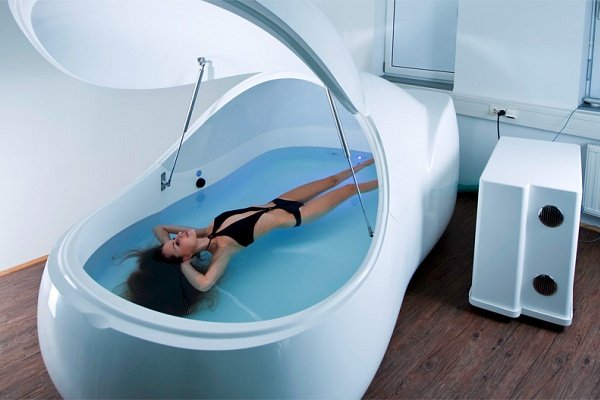14 May 2021, by i-sopod
We were excited to discover that the first ever MRI centred research on floatation therapy was recently carried out, exploring how floatation affects brain activity.
We had a good read of the Laureate Institute’s research paper, and have condensed the main findings into this article – so here’s a digest version of an otherwise quite hefty science paper!
Floatation therapy has long been known to have benefits in short term reduction of anxiety, depression and pain, however until recently, no MRI studies had been done to see how floatation impacts the networks of the brain.
Using FMRI (functional magnetic resonance imaging), scientists at the Laureate Institute for Brain Research put together a study to see the neuro-imaging of Float-REST (reduced environment stimulation therapy).
The idea was to observe whether there are altered patterns in rsFC (resting state functional connectivity), by comparing MRI results from before and after float sessions.
It’s Brain Science
‘Modern society and its ever-growing reliance on digital technology have exposed the human nervous system to an unprecedented level of sensory stimulation. While the capacity to respond and interact with external sensory stimuli constitutes a vital function of the brain, the ability to focus on one’s self and disengage from external stimulation can be just as vital, but is far less studied.’
So what exactly is being monitored in these scans?
The researchers were particularly interested in what differences would appear in the DMN (default mode network), the network which reflects internal mental activity during periods of ‘wakeful rest’. The DMN is spread across two regions in the brain – with its anterior hub in the medial prefrontal cortex, and its posterior hub in the posterior cingulate cortex.
This brain network is typically more active when external sensory stimuli are reduced, and ‘the mind is free to wander and reflect on itself’. Conversely, when the brain is exposed to a high level of external stimulation, activity in the DMN is very much suppressed.
Mind-altering states of being
While REST may refer to the reduction of external sensory stimulation, scientific understanding of how floatation works has evolved from this over the years. Now, the idea of Floatation-REST being merely a form of ‘sensory deprivation’ is considered inaccurate.
During floatation, as the senses are not receiving external stimulation, there is a heightened awareness of internal sensations, such as one’s breath and heartbeat. This is what makes floatation conducive to reaching a meditative state of being.
With that in mind, the scientists wanted to see what would happen with rsFC in the default mode network with REST. While the resting state functional connectivity (rsFC) of the DMN is usually increased when the brain is less exposed to external stimulation, this doesn’t necessarily mean that this is what would occur during Float-REST.
In altered states of consciousness, such as when falling asleep, meditating, under anaesthesia and using psychedelics (e.g psilocybin or ayahuasca), rsFC in the DMN is commonly decreased.
This pattern has been linked to the degree of ‘ego dissolution’ that is noted in these experiences, and to how ‘mental chatter’ is minimised.
You could say that in these altered states of consciousness, as one moves away from a ‘thinking’ state, there is less activity in the DMN, which is the network responsible for more inward based mental processes.
As a contrast, excessive activity in the DMN is seen in depression, when it’s easy to get stuck in the mental chatter, and get overwhelmed by negative thoughts. This goes to show how it’s not as straightforward as less stimulation = calmer brain: the crux of the matter lies in how much we get wrapped in thinking as opposed to being, i.e similar to a meditative state.
Floatation has ‘been found to induce altered states of consciousness, often described as a liminal state, somewhere between being asleep and awake’. The researchers were therefore interested to see how REST would impact the DMN, considering how often floaters report a meditative state, whilst the influx of stimulation via the nervous system is reduced.
The Experiment
The study took place with 48 participants, half of which received float therapy sessions, and the other half underwent Chair-REST for a comparative look at how the brain would respond.
In Chair-REST, participants lie in supine position in a zero-gravity chair, in a fully dark room with similar elements of sensory reduction, making it relatively similar to floatation.
There are of course some big differences between the two forms of REST:
- In Chair-REST there is no water or salt involved.
- Despite the chair being zero-gravity, there is still some pressure on the body and on the spine.
- Participants are fully clothed in Chair-REST, and naked in Float-REST.
- Float-REST is done at a temperature which matches skin temperature, Chair-REST is done in ordinary room temperatures.
- The level of sensory reduction is not quite the same in Chair-REST, as the environment does not eliminate all external light and sound as in a float tank.
Floatation is clearly a more immersive experience, and so it’s interesting to see how the two compare on the brain scans, as it will help to identify what aspects of REST (whether via floatation or other therapy) is having more impact on the brain networks.
The Testing
All subjects were given three 90min sessions of either therapy over three weeks. They had an MRI scan before and after each session, to observe the differences in DMN activity. The participants were also given a questionnaire to complete, to assess their anxiety levels, in which they self rated their level of calm and sleepiness, before and after the REST sessions.

The Results
The MRI results revealed that a 90 min Float-REST session significantly decreased rsFC in the brain’s DMN.Comparing the pre-float MRI with the post-float scan, the reduction in this brain activity in the post-float MRI suggested that REST actually reduces mental processes directed toward one’s physicality, meaning more of an inward mental focus.
This makes extra sense considering how many floaters report having out-of-body experiences during floatation, therefore ‘creating a sense of self’, making it akin to other mind-altering states.
How does this happen? The functioning connectivity between the temporoparietal junction and the posterior insula is rapidly altered during Float-REST, which, in simpler terms, marks a shift in self-location perspective (i.e ‘the experience of where I am in the world’) and in first person perspective (i.e ‘the experience of where I perceive the world from’).
The posterior insula is closely linked to both the somatosensory cortices and the posterior cingulate (governed by the DMN) which suggests interplay between the physical experience of floating (e.g reduction of muscle tension) and how that intervenes with one’s sense of self, and being in a restful state.
‘In an exploratory correlation analysis, we found that the greater the decrease in connectivity between posterior insula and somatosensory cortices, the greater the serenity induced by the float experience, highlighting a potentially important role for these somatosensory rsFC changes in eliciting subjective relaxation.’
In comparison to the results from the Chair-REST sessions, it was clear that while there was also a notable decrease in rsFC in these subjects, it was considerably less of a change than that seen in Float-REST:
‘When comparing the degree of rsFC change, it became evident that the Chair-REST condition did not elicit as robust of a reduction in rsFC as the Float-REST condition.’
This suggests that the total weightlessness and full restriction of external stimuli during floatation are both responsible factors in how much more the brain is impacted, in comparison with Chair-REST. It’s the combination of the physical release and relaxation, (as observed in the somatosensory cortices) with the reduced stimulation, which seem to impact the DMN with decreased rsFC:
‘Reduced stimulation of the nervous system appears to be reflected by reduced rsFC within the brain networks most responsible for creating and mapping our sense of self.’
Also in comparison between the two therapies, there was a significant decrease in anxiety and increase in serenity reported in the Float-REST subjects, more so than in the Chair-REST subjects.
Moreover, those who had the floatation therapy found their experience to be a lot more pleasurable than the chair therapy participants… which shouldn’t come as too much of a surprise if you’re a floater!!
To conclude, this is only the first of what we hope will be many neuro-imaging studies into the effects of Float-REST on the brain, as there is clearly a lot more to learn about exactly how floatation works on the mind.






